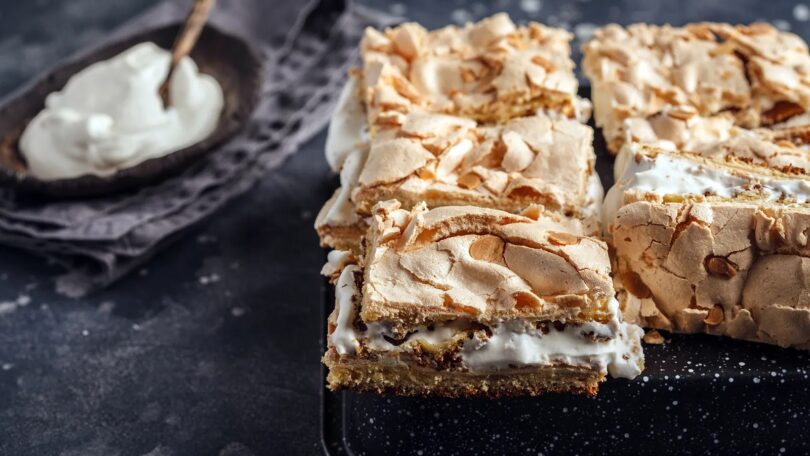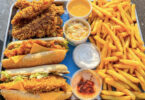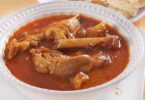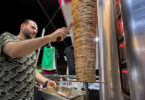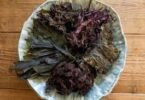Laura Hall
In Norway, there is a cake for just about every celebration and event. For weddings, there is the tower-like kransekake, made of 15 to 20 ground almond-and-egg white rings stacked in concentric circles. At birthdays, a layered sponge cake with cream and berries called bløtkake is served. And for general success, Norwegians enjoy an aptly named “success cake”, made of almond meringue and a vivid yellow layer of custard.
While each of these cakes is made to celebrate specific special moments, there is one cake that is at home at every kind of celebration. That cake is the ??Kvæfjordkake, also known as the verdens beste (world’s best) cake.
The cake is a lush, layered confection that brings together custard and cream, the crunch of almonds and the snap of meringue, plus the steadying base of a light, airy sponge cake.
“It’s the national cake of Norway,” said Nevada Berg, who published her second cookbook, Norwegian Baking through the Seasons, in April 2023. The book features 90 sweet and savoury recipes, including traditional baked goods for Norwegian holidays and other special occasions. In addition to authoring cookbooks, Berg publishes a blog called Northwildkitchen, and also offers in-person cookery tours around Norway and online cookery classes.
“I love this cake! It definitely lives up to its name. It is one of the first cakes I had in Norway,” said Berg, who moved from Utah in the US to Norway in 2015. “There are so many amazing flavours and interesting regional traditions in Norway and it’s good to be able to bring them to the world. The Norwegian cake tradition is very different to the US one. There are not so many ingredients and fewer nationalities influencing how cakes are made.”
The origins of Kvæfjordkake date to the 1930s, when cattle farmer and baker Hulda Ottestad bought some recipes from a Danish pastry chef to expand the range of cakes she was offering at Café Alliance, the bakery she ran with her sister in Harstad, a small city in in Northern Norway. One of the cakes was the kongekage, a Danish cake that used a lot of almonds. Since the nuts were pricey, she adapted the recipe and cut back on the quantity of nuts. In time, the cake grew in popularity and the recipe was tweaked as it passed around homes. It became known as the Kvæfjordkake, after the Kvæfjord area Ottestad came from.
In the 1970s, the Norwegian newspaper Norsk Ukeblad featured the cake, and it became a national success. Thirty years later, in 2002, Nitimen, a national radio show, asked its listeners to help them choose the best cake in Norway, and the Kvæfjordkake was unanimously voted as number one, above the kransekake, carrot cake, marzipan cake and chocolate cake. It has since become known as “the world’s best”, in Norway at least.
The cake is now recognised as the official cake of Norway, and is still eaten with much pride in Kvæfjord today. Next to the ferry port in the town of Refsnes, Susanne Hentschel runs a garden cafe called Refsnes Matglede with her husband. They see a lot of demand for the creamy, custardy creation.
“It’s one of the bestsellers in our coffee shop,” she said. “If four Norwegians come for a coffee, unless they are feeling very experimental, they usually order four slices of Kvæfjordkake. Swedes might order four different types of cake, but Norwegians usually choose this one.”
When at home, Berg’s advice on making the world’s best cake is to take it slow when you come to the final assembly stage.
“I was told it would be quite difficult to make, but it has turned out for me to be a very forgiving cake,” she said. “The homemade custard looks daunting to make, but it’s not. The meringue is not baked like a pavlova, where you have to have a certain temperature to get it just right.
“The hardest thing is at the end, when you have to divide the cake in half, with the meringue flipped to the bottom,” cautioned Berg. “Timing it and making sure it doesn’t break is tricky!”
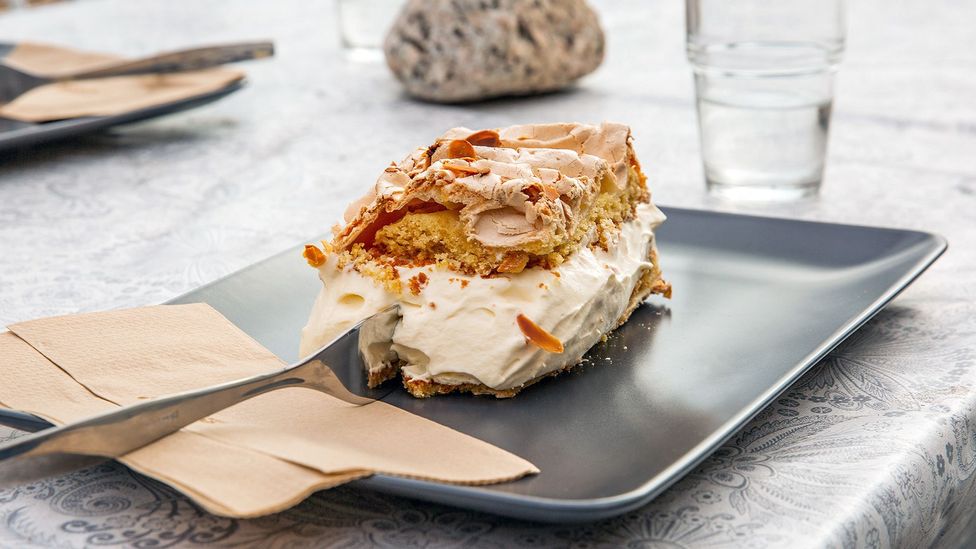
This is the Kvæfjordkake as served at Norway’s Refsnes Matglede (Credit: Susanne Hentschel)
Kvæfjordkake: The World’s Best Cake recipe
By Nevada Berg
This celebratory cake is easy to make and can be made a day in advance of a big event. The only tricky part is assembly – take it steady and be careful when you flip it!
Serves 12
Method
Step 1
For the cake, preheat the oven to 165C (325F). Butter a 40 x 30 cm (16 x 12 inch) rimmed baking sheet and line it with baking paper (parchment), pressing down so the paper sticks to the baking sheet.
Step 2
In a medium bowl, whisk together the flour and baking powder.
Step 3
Fit a stand mixer with a paddle attachment and beat the butter and sugar together until light and fluffy. Add the egg yolks, 1 at a time, beating until incorporated. Add the milk and vanilla and beat until blended. Add the flour mixture, beating until incorporated; the batter should be somewhat thick and sticky. Using a rubber spatula, carefully spread the batter evenly across the prepared baking sheet, going as far to the edges as possible, while maintaining a rectangular shape.
Step 4
For the meringue, in a stand mixer fitted with the whisk attachment, whip the egg whites on medium until foamy. Gradually add the sugar, whipping until glossy stiff peaks form. Pour the meringue over the batter on the baking sheet and use a spatula to spread it evenly, lifting upwards to form little peaks. Sprinkle the sliced almonds on top. Bake for about 30 minutes, or until the meringue is dry and lightly golden. Set aside to cool.
Step 5
For the custard, in a large bowl, whisk together the sugar and egg yolks. Add the cornflour and whisk until thick and pale yellow.
Step 6
Put the milk in a small saucepan. Scrape the seeds from the vanilla bean into the milk and add the scraped bean (or add the vanilla extract). Warm over medium heat until just beginning to simmer then remove from the heat. Remove the vanilla bean, then slowly add the milk to the egg yolk mixture, whisking constantly to avoid curdling the eggs. Pour the mixture back into the saucepan and place over medium heat. Cook, stirring constantly, until thick. Set aside to cool.
Step 7
For the whipped cream, whip the heavy cream until stiff peaks form. Fold into the cooled custard.
Step 8
To assemble, use the paper to lift the cake out of the baking sheet and place, meringue side up, on a large cutting board with the long sides horizontal. Cut the cake vertically in half so that you have two equal size cakes. Carefully hold a large serving tray with one hand over the top of one of the cakes. Place the other hand under the cake, and flip it over onto the serving tray, so the meringue side is facing down on the tray. Peel away the paper. Spread the custard cream over the cake on the serving tray. Peel away the paper from the other cake and gently place it, meringue side up, on top of the custard cream to form one cake. Chill in the refrigerator for an hour or so before serving. Keep covered in the refrigerator for 3 to 4 days.

